 During Chris’ health problems this spring, we wondered for a
time whether we’d be going sailing this summer. However, his recovery has been
dramatically better than we could have hoped and he is now pretty much back to normal
though with some residual dizziness and tiredness. So we decided to come up to the boat
in Scotland, without any grand plans or commitments, just to see how things would go.
There are many places new to us within quite a short range of our marina in Craobh –
Loch Linnhe and the mainland areas of Morvern, Morar, Moidart and Knoydart and some
inner Hebridean islands. It would be good to explore these rather than rushing off past
them as we might do if our eyes were set on some more distant target.
During Chris’ health problems this spring, we wondered for a
time whether we’d be going sailing this summer. However, his recovery has been
dramatically better than we could have hoped and he is now pretty much back to normal
though with some residual dizziness and tiredness. So we decided to come up to the boat
in Scotland, without any grand plans or commitments, just to see how things would go.
There are many places new to us within quite a short range of our marina in Craobh –
Loch Linnhe and the mainland areas of Morvern, Morar, Moidart and Knoydart and some
inner Hebridean islands. It would be good to explore these rather than rushing off past
them as we might do if our eyes were set on some more distant target.
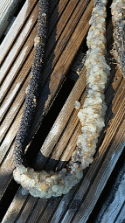 We arrived back on Aremiti in the midst of the
fabulously dry sunny weather enjoyed all over the country. Hard to believe that this
included Scotland! As usual, on arrival back onboard – this time after 9 months absence
- we were faced with an apparently insurmountable list of tasks to be completed before
setting off – all clamouring to be done first. These included the routine annual
maintenance chores such as engine servicing (always music to our ears when the engine
springs into life at the first turn!), cleaning the boat inside and out, repainting the
deck, cleaning and sealing the teak, and provisioning the boat with basic stock cupboard
items for the summer. Also, every year, we make a number of modifications to the boat.
You might think after 15 years ownership we had made every conceivable modification –
but no – we keep coming up with more. This time included the installation of a new super
powerful wifi hub, fitting an additional couple of electrical sockets in different parts
of the boat and redesigning the radio/CD fitting. And then of course there are the
unanticipated jobs. Although we arrived to find Aremiti sound and clean, several lockers
had developed a coating of mildew and in another the headlining had collapsed. So two
immediate extra jobs before we could even start stowing the innumerable items we’d
brought up from home. Another unanticipated job was to clear a couple of mooring ropes
which had been dangling in the water, of strings of tiny mussels!
We arrived back on Aremiti in the midst of the
fabulously dry sunny weather enjoyed all over the country. Hard to believe that this
included Scotland! As usual, on arrival back onboard – this time after 9 months absence
- we were faced with an apparently insurmountable list of tasks to be completed before
setting off – all clamouring to be done first. These included the routine annual
maintenance chores such as engine servicing (always music to our ears when the engine
springs into life at the first turn!), cleaning the boat inside and out, repainting the
deck, cleaning and sealing the teak, and provisioning the boat with basic stock cupboard
items for the summer. Also, every year, we make a number of modifications to the boat.
You might think after 15 years ownership we had made every conceivable modification –
but no – we keep coming up with more. This time included the installation of a new super
powerful wifi hub, fitting an additional couple of electrical sockets in different parts
of the boat and redesigning the radio/CD fitting. And then of course there are the
unanticipated jobs. Although we arrived to find Aremiti sound and clean, several lockers
had developed a coating of mildew and in another the headlining had collapsed. So two
immediate extra jobs before we could even start stowing the innumerable items we’d
brought up from home. Another unanticipated job was to clear a couple of mooring ropes
which had been dangling in the water, of strings of tiny mussels!
 This past winter, unusually, we’d left the boat in the water.
Having discovered our ‘mussel farm’, we were anxious about the state of the hull and
propellor – though we had been advised that there is typically very little growth in
these waters. We’d like to have been hauled out for a look and maybe a splash of
anti-fouling, but the yard were unable to fit us into their schedule. Chris took a dive
to check the situation underwater, and found the prop encased in a large ball of
seaweed. He scraped this off successfully, though the operation exacerbated his
dizziness …. Luckily, a gigantic mass of jellyfish which had congregated in the marina a
couple of days earlier, had by then disappeared - as mysteriously as they had come.
This past winter, unusually, we’d left the boat in the water.
Having discovered our ‘mussel farm’, we were anxious about the state of the hull and
propellor – though we had been advised that there is typically very little growth in
these waters. We’d like to have been hauled out for a look and maybe a splash of
anti-fouling, but the yard were unable to fit us into their schedule. Chris took a dive
to check the situation underwater, and found the prop encased in a large ball of
seaweed. He scraped this off successfully, though the operation exacerbated his
dizziness …. Luckily, a gigantic mass of jellyfish which had congregated in the marina a
couple of days earlier, had by then disappeared - as mysteriously as they had come.
 The glorious hot sunny weather persisted during this
time and we enjoyed idyllic evenings eating and relaxing in the cockpit, gazing over the
islands and hills beckoning us from outside the marina. This was completely unimaginable
after our dire meteorological experiences last year – we had no idea Scotland was
capable of such wonder!
The glorious hot sunny weather persisted during this
time and we enjoyed idyllic evenings eating and relaxing in the cockpit, gazing over the
islands and hills beckoning us from outside the marina. This was completely unimaginable
after our dire meteorological experiences last year – we had no idea Scotland was
capable of such wonder!
Gradually the jobs were ticked off and it was wonderful, finally, to break free – though
we felt some trepidation as to how Chris would handle some actual sailing. 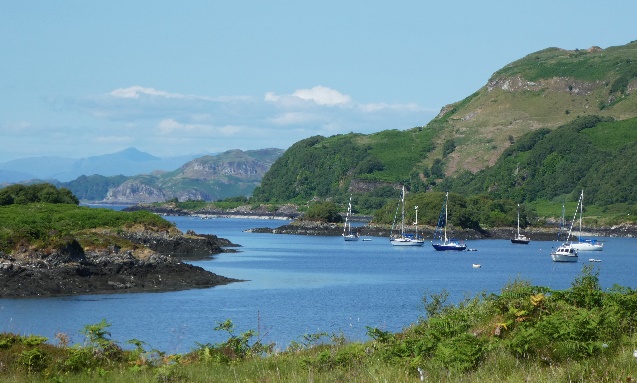 The forecast drizzle did not materialise and although there
was no wind, we enjoyed a very pleasant first short passage, rounding up into the Sound
of Luing to catch the excellent north going tide – up to 5 knots, then passing familiar
landmarks – the cliffs of southern Mull, the lighthouse island of Fladda, Easdale and
then into our favourite first anchorage of Puilladobhrain – in time for tea! We enjoyed
a couple of days of relaxation including a walk taking us down the coast before turning
inland, finally arriving at the Clachan ‘Bridge over the Atlantic’ and the ‘ Tigh an
Truish’ pub in time for a pre-dinner drink in the sunshine, before a very delicious
meal, starting with an amuse bouche brought to us by William - the chef/owner, who was a
‘MasterChef the Professionals’ contestant last year!
The forecast drizzle did not materialise and although there
was no wind, we enjoyed a very pleasant first short passage, rounding up into the Sound
of Luing to catch the excellent north going tide – up to 5 knots, then passing familiar
landmarks – the cliffs of southern Mull, the lighthouse island of Fladda, Easdale and
then into our favourite first anchorage of Puilladobhrain – in time for tea! We enjoyed
a couple of days of relaxation including a walk taking us down the coast before turning
inland, finally arriving at the Clachan ‘Bridge over the Atlantic’ and the ‘ Tigh an
Truish’ pub in time for a pre-dinner drink in the sunshine, before a very delicious
meal, starting with an amuse bouche brought to us by William - the chef/owner, who was a
‘MasterChef the Professionals’ contestant last year!
This year is predicted to be a very bad one for midges in Scotland – but happily so far,
we haven’t encountered any of the little beasts. Chris has discovered a Midge Forecast
app – so we can now factor the midge situation into our planning. Luckily, they seem
generally to prefer inland areas.
 Moving on to Oban, the weather started becoming less
reliable. Typically forecasts tended to be overly pessimistic as we’d wake to drizzle
but end up bathing in warm sunshine by the afternoon. During our time in Oban we enjoyed
the abundant sea-food stalls around the ferry port and a good walk south down the Sound
of Kerrera and back to a panoramic view of the town and beyond up Loch Linnhe and across
to the Sound of Mull.
Moving on to Oban, the weather started becoming less
reliable. Typically forecasts tended to be overly pessimistic as we’d wake to drizzle
but end up bathing in warm sunshine by the afternoon. During our time in Oban we enjoyed
the abundant sea-food stalls around the ferry port and a good walk south down the Sound
of Kerrera and back to a panoramic view of the town and beyond up Loch Linnhe and across
to the Sound of Mull.
 We had arrived in Oban during the annual International Shanty
Festival – something new to us. While we enjoyed some of the performances, we probably
won’t be exploring the genre further! The pure form of unaccompanied shanty singing
didn’t appeal, though a trio from Brittany accompanying themselves brilliantly on a
variety of instruments captivated us with their typically French wit and charm!
We had arrived in Oban during the annual International Shanty
Festival – something new to us. While we enjoyed some of the performances, we probably
won’t be exploring the genre further! The pure form of unaccompanied shanty singing
didn’t appeal, though a trio from Brittany accompanying themselves brilliantly on a
variety of instruments captivated us with their typically French wit and charm!
Our next move was a short passage – 9 miles of gentle progress under genny and mizzen
with good current – up alongside the east side of the island of Lismore, which lies at
the mouth of Loch Linnhe. While other yachts continued up – we assumed - towards the
entrance to the Caledonian Canal further up, we diverted into Loch Creran to find a
delightfully pretty spot to anchor, in South Shian Bay, alongside a spit dotted with
trees and a small colony of seals. We relished a sunny warm afternoon – on what turned
out to be our final day of good weather.
The forecasts stretching ahead predicted much rain and little wind. We had planned to
explore further into Loch Linnhe hoping for views of the Great Glen, complete with Ben
Nevis, to open up before us, but in the ‘dreich’ conditions this wasn’t going to happen.
The midge forecast wasn’t looking good for that area anyway! Instead, having motored up
and down Loch Creran for a look, and passing Port Appin, we headed for Port Ramsey at
the northern end of the island of Lismore, threading our way through rocky islets into
the anchorage – though having no landing other than the beach, this could hardly be
described as a port. 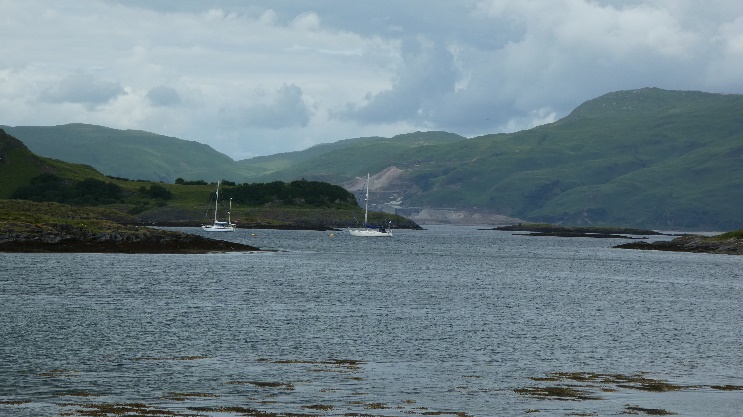
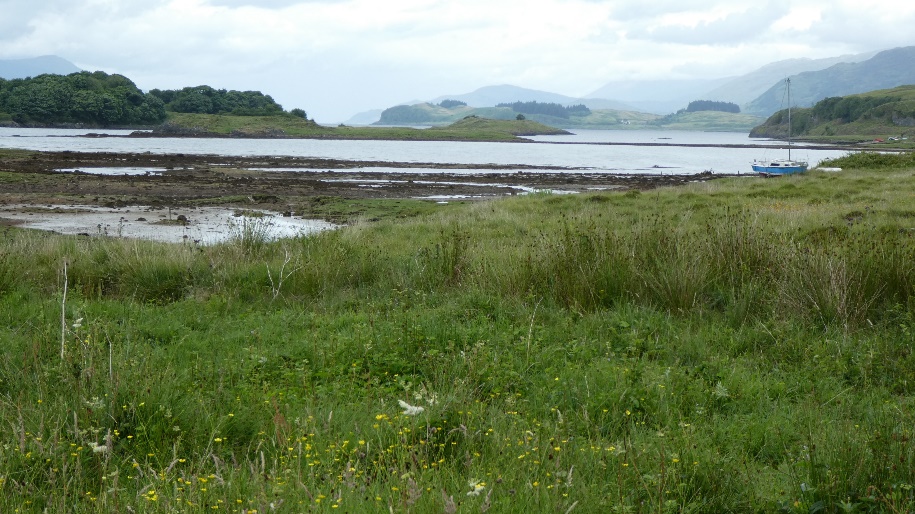 We were rewarded by a brief appearance of the sun! Lismore –
meaning ‘Big Garden’ – is a long, narrow, low lying green island with a population of
192. It has been inhabited since the Bronze Age with many ruins from that era, and was a
centre of Christianity from the sixth century. The monastery was founded in 564 by St
Moluag – a contemporary of St Columba. The story goes that St Molaug and St Mulhac were
in competition to found a monastery on the island. Racing across the Lyn of Lorn to the
island, St Molaug, who was falling behind, cut off his finger and threw it ashore in
order to claim first arrival!
We were rewarded by a brief appearance of the sun! Lismore –
meaning ‘Big Garden’ – is a long, narrow, low lying green island with a population of
192. It has been inhabited since the Bronze Age with many ruins from that era, and was a
centre of Christianity from the sixth century. The monastery was founded in 564 by St
Moluag – a contemporary of St Columba. The story goes that St Molaug and St Mulhac were
in competition to found a monastery on the island. Racing across the Lyn of Lorn to the
island, St Molaug, who was falling behind, cut off his finger and threw it ashore in
order to claim first arrival!
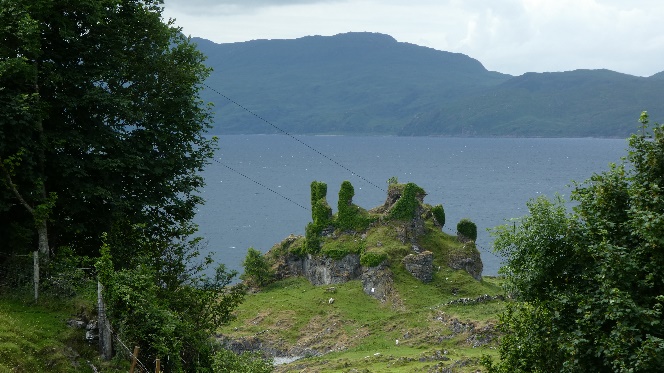 Optimistically we set off on a walk the next day passing a row of tiny white cottages
built for lime quarrymen, enjoying the abundance of wild flowers. Along the coast,
through a hazel grove, along wooded escarpment across boggy land, past the ruins of 13th
century Coeffin Castle. Then inland to the excellent Lismore Heritage Centre. Sadly the
walk back was in light drizzle and decreasing visibility – so again, no views up the
Great Glen!
Optimistically we set off on a walk the next day passing a row of tiny white cottages
built for lime quarrymen, enjoying the abundance of wild flowers. Along the coast,
through a hazel grove, along wooded escarpment across boggy land, past the ruins of 13th
century Coeffin Castle. Then inland to the excellent Lismore Heritage Centre. Sadly the
walk back was in light drizzle and decreasing visibility – so again, no views up the
Great Glen!
Our whole (14.5 mile) passage to Lochaline was in steady drizzle. The Glensanda
super-quarry appeared mistily on the Morvern coast. We were intrigued to discover that
this is the largest granite quarry in Europe, accounting for 99% of all aggregate
shipped out of the UK. Since opening in 1986 it has exported 177 million tonnes of stone
all over the world. Set in the remote hills on the shore of Loch Linnhe it has no roads
leading to it – the vision being to build a hard rock quarry close to the water causing
minimum environmental impact. At the centre of the quarry crater which is set back 2km
from the shore, is a vertical shaft - "The Glory Hole" - into which the granite is
tipped down a 230m shaft and along a 1.8km conveyor belt before being ground up. 7
million tons of aggregate are loaded onto ships each year! Sadly they don’t allow
visitors! 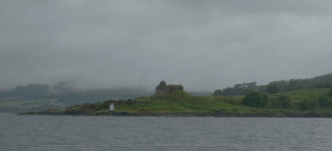 Chris’s planning to take advantage of the tides down to the Sound of Mull and
then, on the turn, up into the Sound to Lochaline was absolutely spot on. Tides are key
in these passages between islands and mainland. We ‘enjoyed’ a wet and windy spell in
Lochaline – which is a bullet-proof haven. Dismal weather prevailed, though we had a
good walk up the loch under the trees sheltering us from the frequent showers to
Ardtornish House and Gardens.
Chris’s planning to take advantage of the tides down to the Sound of Mull and
then, on the turn, up into the Sound to Lochaline was absolutely spot on. Tides are key
in these passages between islands and mainland. We ‘enjoyed’ a wet and windy spell in
Lochaline – which is a bullet-proof haven. Dismal weather prevailed, though we had a
good walk up the loch under the trees sheltering us from the frequent showers to
Ardtornish House and Gardens.
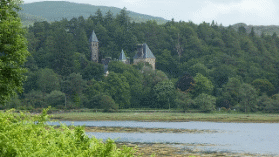 The gardens were very green and lush and Chris was
particularly interested in ‘Archimedes Screw Turbine’ providing electricity for the
house – like a greatly elongated mill wheel. A rare entirely dry day allowed us to take
a morning walk out to the castle at Ardtornish Point with its commanding view of the
Sound of Mull and out into the waters around Oban, followed by an afternoon passage 15
miles up the Sound of Mull to Tobermory.
The gardens were very green and lush and Chris was
particularly interested in ‘Archimedes Screw Turbine’ providing electricity for the
house – like a greatly elongated mill wheel. A rare entirely dry day allowed us to take
a morning walk out to the castle at Ardtornish Point with its commanding view of the
Sound of Mull and out into the waters around Oban, followed by an afternoon passage 15
miles up the Sound of Mull to Tobermory. 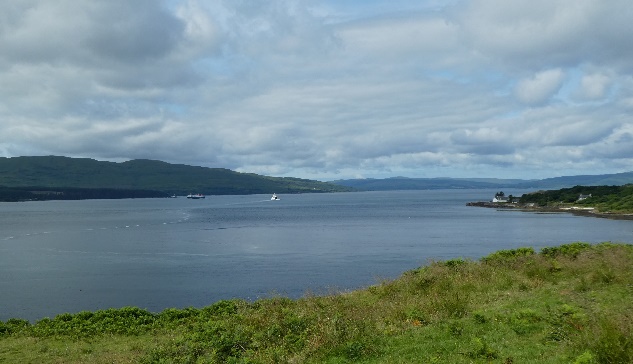 We had perfectly timed the tide, but the wind
was strongly on the nose. Like all but one of the yachts around, we admit we motored.
The very racy looking yacht tacking all the way – and keeping up – was called ‘X Wings’
and crewed by six fit young men – as we noticed when it followed us into the harbour –
so we didn’t feel too bad!
We had perfectly timed the tide, but the wind
was strongly on the nose. Like all but one of the yachts around, we admit we motored.
The very racy looking yacht tacking all the way – and keeping up – was called ‘X Wings’
and crewed by six fit young men – as we noticed when it followed us into the harbour –
so we didn’t feel too bad!
 Now we’re in Tobermory – highlights of which are the Mishnish pub and Brown’s Wine
Merchant and Ironmonger – established 1830 and famed for its eclectic range of goods.
They still sell ukeleles – along with whisky, dog food, stationery, haberdashery items,
kitchen utensils and crockery, watches, as well as everything you’d expect to find in a
hardware shop.
Now we’re in Tobermory – highlights of which are the Mishnish pub and Brown’s Wine
Merchant and Ironmonger – established 1830 and famed for its eclectic range of goods.
They still sell ukeleles – along with whisky, dog food, stationery, haberdashery items,
kitchen utensils and crockery, watches, as well as everything you’d expect to find in a
hardware shop.
 Next we have 3 choices – to head west for the islands of Coll and Tiree, or east into
Loch Sunart. Or we could head round Ardnamurchan Point and northwards for the Small
Isles or east to the remote mainland peninsulas. It all depends on the weather ….
Next we have 3 choices – to head west for the islands of Coll and Tiree, or east into
Loch Sunart. Or we could head round Ardnamurchan Point and northwards for the Small
Isles or east to the remote mainland peninsulas. It all depends on the weather ….
Julia, Chris and Aremiti
 During Chris’ health problems this spring, we wondered for a
time whether we’d be going sailing this summer. However, his recovery has been
dramatically better than we could have hoped and he is now pretty much back to normal
though with some residual dizziness and tiredness. So we decided to come up to the boat
in Scotland, without any grand plans or commitments, just to see how things would go.
There are many places new to us within quite a short range of our marina in Craobh –
Loch Linnhe and the mainland areas of Morvern, Morar, Moidart and Knoydart and some
inner Hebridean islands. It would be good to explore these rather than rushing off past
them as we might do if our eyes were set on some more distant target.
During Chris’ health problems this spring, we wondered for a
time whether we’d be going sailing this summer. However, his recovery has been
dramatically better than we could have hoped and he is now pretty much back to normal
though with some residual dizziness and tiredness. So we decided to come up to the boat
in Scotland, without any grand plans or commitments, just to see how things would go.
There are many places new to us within quite a short range of our marina in Craobh –
Loch Linnhe and the mainland areas of Morvern, Morar, Moidart and Knoydart and some
inner Hebridean islands. It would be good to explore these rather than rushing off past
them as we might do if our eyes were set on some more distant target.  We arrived back on Aremiti in the midst of the
fabulously dry sunny weather enjoyed all over the country. Hard to believe that this
included Scotland! As usual, on arrival back onboard – this time after 9 months absence
- we were faced with an apparently insurmountable list of tasks to be completed before
setting off – all clamouring to be done first. These included the routine annual
maintenance chores such as engine servicing (always music to our ears when the engine
springs into life at the first turn!), cleaning the boat inside and out, repainting the
deck, cleaning and sealing the teak, and provisioning the boat with basic stock cupboard
items for the summer. Also, every year, we make a number of modifications to the boat.
You might think after 15 years ownership we had made every conceivable modification –
but no – we keep coming up with more. This time included the installation of a new super
powerful wifi hub, fitting an additional couple of electrical sockets in different parts
of the boat and redesigning the radio/CD fitting. And then of course there are the
unanticipated jobs. Although we arrived to find Aremiti sound and clean, several lockers
had developed a coating of mildew and in another the headlining had collapsed. So two
immediate extra jobs before we could even start stowing the innumerable items we’d
brought up from home. Another unanticipated job was to clear a couple of mooring ropes
which had been dangling in the water, of strings of tiny mussels!
We arrived back on Aremiti in the midst of the
fabulously dry sunny weather enjoyed all over the country. Hard to believe that this
included Scotland! As usual, on arrival back onboard – this time after 9 months absence
- we were faced with an apparently insurmountable list of tasks to be completed before
setting off – all clamouring to be done first. These included the routine annual
maintenance chores such as engine servicing (always music to our ears when the engine
springs into life at the first turn!), cleaning the boat inside and out, repainting the
deck, cleaning and sealing the teak, and provisioning the boat with basic stock cupboard
items for the summer. Also, every year, we make a number of modifications to the boat.
You might think after 15 years ownership we had made every conceivable modification –
but no – we keep coming up with more. This time included the installation of a new super
powerful wifi hub, fitting an additional couple of electrical sockets in different parts
of the boat and redesigning the radio/CD fitting. And then of course there are the
unanticipated jobs. Although we arrived to find Aremiti sound and clean, several lockers
had developed a coating of mildew and in another the headlining had collapsed. So two
immediate extra jobs before we could even start stowing the innumerable items we’d
brought up from home. Another unanticipated job was to clear a couple of mooring ropes
which had been dangling in the water, of strings of tiny mussels!  This past winter, unusually, we’d left the boat in the water.
Having discovered our ‘mussel farm’, we were anxious about the state of the hull and
propellor – though we had been advised that there is typically very little growth in
these waters. We’d like to have been hauled out for a look and maybe a splash of
anti-fouling, but the yard were unable to fit us into their schedule. Chris took a dive
to check the situation underwater, and found the prop encased in a large ball of
seaweed. He scraped this off successfully, though the operation exacerbated his
dizziness …. Luckily, a gigantic mass of jellyfish which had congregated in the marina a
couple of days earlier, had by then disappeared - as mysteriously as they had come.
This past winter, unusually, we’d left the boat in the water.
Having discovered our ‘mussel farm’, we were anxious about the state of the hull and
propellor – though we had been advised that there is typically very little growth in
these waters. We’d like to have been hauled out for a look and maybe a splash of
anti-fouling, but the yard were unable to fit us into their schedule. Chris took a dive
to check the situation underwater, and found the prop encased in a large ball of
seaweed. He scraped this off successfully, though the operation exacerbated his
dizziness …. Luckily, a gigantic mass of jellyfish which had congregated in the marina a
couple of days earlier, had by then disappeared - as mysteriously as they had come.  The glorious hot sunny weather persisted during this
time and we enjoyed idyllic evenings eating and relaxing in the cockpit, gazing over the
islands and hills beckoning us from outside the marina. This was completely unimaginable
after our dire meteorological experiences last year – we had no idea Scotland was
capable of such wonder!
The glorious hot sunny weather persisted during this
time and we enjoyed idyllic evenings eating and relaxing in the cockpit, gazing over the
islands and hills beckoning us from outside the marina. This was completely unimaginable
after our dire meteorological experiences last year – we had no idea Scotland was
capable of such wonder!  The forecast drizzle did not materialise and although there
was no wind, we enjoyed a very pleasant first short passage, rounding up into the Sound
of Luing to catch the excellent north going tide – up to 5 knots, then passing familiar
landmarks – the cliffs of southern Mull, the lighthouse island of Fladda, Easdale and
then into our favourite first anchorage of Puilladobhrain – in time for tea! We enjoyed
a couple of days of relaxation including a walk taking us down the coast before turning
inland, finally arriving at the Clachan ‘Bridge over the Atlantic’ and the ‘ Tigh an
Truish’ pub in time for a pre-dinner drink in the sunshine, before a very delicious
meal, starting with an amuse bouche brought to us by William - the chef/owner, who was a
‘MasterChef the Professionals’ contestant last year!
The forecast drizzle did not materialise and although there
was no wind, we enjoyed a very pleasant first short passage, rounding up into the Sound
of Luing to catch the excellent north going tide – up to 5 knots, then passing familiar
landmarks – the cliffs of southern Mull, the lighthouse island of Fladda, Easdale and
then into our favourite first anchorage of Puilladobhrain – in time for tea! We enjoyed
a couple of days of relaxation including a walk taking us down the coast before turning
inland, finally arriving at the Clachan ‘Bridge over the Atlantic’ and the ‘ Tigh an
Truish’ pub in time for a pre-dinner drink in the sunshine, before a very delicious
meal, starting with an amuse bouche brought to us by William - the chef/owner, who was a
‘MasterChef the Professionals’ contestant last year!  Moving on to Oban, the weather started becoming less
reliable. Typically forecasts tended to be overly pessimistic as we’d wake to drizzle
but end up bathing in warm sunshine by the afternoon. During our time in Oban we enjoyed
the abundant sea-food stalls around the ferry port and a good walk south down the Sound
of Kerrera and back to a panoramic view of the town and beyond up Loch Linnhe and across
to the Sound of Mull.
Moving on to Oban, the weather started becoming less
reliable. Typically forecasts tended to be overly pessimistic as we’d wake to drizzle
but end up bathing in warm sunshine by the afternoon. During our time in Oban we enjoyed
the abundant sea-food stalls around the ferry port and a good walk south down the Sound
of Kerrera and back to a panoramic view of the town and beyond up Loch Linnhe and across
to the Sound of Mull.  We had arrived in Oban during the annual International Shanty
Festival – something new to us. While we enjoyed some of the performances, we probably
won’t be exploring the genre further! The pure form of unaccompanied shanty singing
didn’t appeal, though a trio from Brittany accompanying themselves brilliantly on a
variety of instruments captivated us with their typically French wit and charm!
We had arrived in Oban during the annual International Shanty
Festival – something new to us. While we enjoyed some of the performances, we probably
won’t be exploring the genre further! The pure form of unaccompanied shanty singing
didn’t appeal, though a trio from Brittany accompanying themselves brilliantly on a
variety of instruments captivated us with their typically French wit and charm! 
 We were rewarded by a brief appearance of the sun! Lismore –
meaning ‘Big Garden’ – is a long, narrow, low lying green island with a population of
192. It has been inhabited since the Bronze Age with many ruins from that era, and was a
centre of Christianity from the sixth century. The monastery was founded in 564 by St
Moluag – a contemporary of St Columba. The story goes that St Molaug and St Mulhac were
in competition to found a monastery on the island. Racing across the Lyn of Lorn to the
island, St Molaug, who was falling behind, cut off his finger and threw it ashore in
order to claim first arrival!
We were rewarded by a brief appearance of the sun! Lismore –
meaning ‘Big Garden’ – is a long, narrow, low lying green island with a population of
192. It has been inhabited since the Bronze Age with many ruins from that era, and was a
centre of Christianity from the sixth century. The monastery was founded in 564 by St
Moluag – a contemporary of St Columba. The story goes that St Molaug and St Mulhac were
in competition to found a monastery on the island. Racing across the Lyn of Lorn to the
island, St Molaug, who was falling behind, cut off his finger and threw it ashore in
order to claim first arrival!  Optimistically we set off on a walk the next day passing a row of tiny white cottages
built for lime quarrymen, enjoying the abundance of wild flowers. Along the coast,
through a hazel grove, along wooded escarpment across boggy land, past the ruins of 13th
century Coeffin Castle. Then inland to the excellent Lismore Heritage Centre. Sadly the
walk back was in light drizzle and decreasing visibility – so again, no views up the
Great Glen!
Optimistically we set off on a walk the next day passing a row of tiny white cottages
built for lime quarrymen, enjoying the abundance of wild flowers. Along the coast,
through a hazel grove, along wooded escarpment across boggy land, past the ruins of 13th
century Coeffin Castle. Then inland to the excellent Lismore Heritage Centre. Sadly the
walk back was in light drizzle and decreasing visibility – so again, no views up the
Great Glen!  Chris’s planning to take advantage of the tides down to the Sound of Mull and
then, on the turn, up into the Sound to Lochaline was absolutely spot on. Tides are key
in these passages between islands and mainland. We ‘enjoyed’ a wet and windy spell in
Lochaline – which is a bullet-proof haven. Dismal weather prevailed, though we had a
good walk up the loch under the trees sheltering us from the frequent showers to
Ardtornish House and Gardens.
Chris’s planning to take advantage of the tides down to the Sound of Mull and
then, on the turn, up into the Sound to Lochaline was absolutely spot on. Tides are key
in these passages between islands and mainland. We ‘enjoyed’ a wet and windy spell in
Lochaline – which is a bullet-proof haven. Dismal weather prevailed, though we had a
good walk up the loch under the trees sheltering us from the frequent showers to
Ardtornish House and Gardens.
 The gardens were very green and lush and Chris was
particularly interested in ‘Archimedes Screw Turbine’ providing electricity for the
house – like a greatly elongated mill wheel. A rare entirely dry day allowed us to take
a morning walk out to the castle at Ardtornish Point with its commanding view of the
Sound of Mull and out into the waters around Oban, followed by an afternoon passage 15
miles up the Sound of Mull to Tobermory.
The gardens were very green and lush and Chris was
particularly interested in ‘Archimedes Screw Turbine’ providing electricity for the
house – like a greatly elongated mill wheel. A rare entirely dry day allowed us to take
a morning walk out to the castle at Ardtornish Point with its commanding view of the
Sound of Mull and out into the waters around Oban, followed by an afternoon passage 15
miles up the Sound of Mull to Tobermory.  We had perfectly timed the tide, but the wind
was strongly on the nose. Like all but one of the yachts around, we admit we motored.
The very racy looking yacht tacking all the way – and keeping up – was called ‘X Wings’
and crewed by six fit young men – as we noticed when it followed us into the harbour –
so we didn’t feel too bad!
We had perfectly timed the tide, but the wind
was strongly on the nose. Like all but one of the yachts around, we admit we motored.
The very racy looking yacht tacking all the way – and keeping up – was called ‘X Wings’
and crewed by six fit young men – as we noticed when it followed us into the harbour –
so we didn’t feel too bad!  Now we’re in Tobermory – highlights of which are the Mishnish pub and Brown’s Wine
Merchant and Ironmonger – established 1830 and famed for its eclectic range of goods.
They still sell ukeleles – along with whisky, dog food, stationery, haberdashery items,
kitchen utensils and crockery, watches, as well as everything you’d expect to find in a
hardware shop.
Now we’re in Tobermory – highlights of which are the Mishnish pub and Brown’s Wine
Merchant and Ironmonger – established 1830 and famed for its eclectic range of goods.
They still sell ukeleles – along with whisky, dog food, stationery, haberdashery items,
kitchen utensils and crockery, watches, as well as everything you’d expect to find in a
hardware shop.  Next we have 3 choices – to head west for the islands of Coll and Tiree, or east into
Loch Sunart. Or we could head round Ardnamurchan Point and northwards for the Small
Isles or east to the remote mainland peninsulas. It all depends on the weather ….
Next we have 3 choices – to head west for the islands of Coll and Tiree, or east into
Loch Sunart. Or we could head round Ardnamurchan Point and northwards for the Small
Isles or east to the remote mainland peninsulas. It all depends on the weather ….